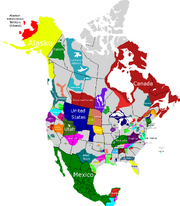Even though it is part of the 1983: Doomsday Timeline, its creator or creators have more work to do before it can be complete. You are welcome to give suggestions at the Talk Page. |
The American Spring (also known as the Second American Revolution or the 2011 North American protests) are an unprecedented revolutionary wave of demonstrations and protests which have been taking place among the successor states of the United States of America. Beginning in March 2011 with the Committee to Restore the United States of America (CRUSA) sponsored pro-democracy protests in the Municipal States of the Pacific, the protests have evolved into new calls to unite the scattered survivor states under the Stars and Stripes again. The protests have shared techniques of civil resistance in sustained campaigns involving strikes, demonstrations, marches and rallies, as well as the support of CRUSA agents in organizing and sustaining these protests.
Background

North America prior to the American Spring
The continental United States was badly damaged following Doomsday and convinced the remnant of the American government to relocate to Australia. The American Provisional Administration, left in control of only Hawaii, rump Alaska and various island territories scattered throughout the Pacific, attempted to keep the United States alive. Failure, however, to establish control over mainland American territory following the Crescent City Crisis and the huge financial burden placed on Australia convinced President George H. W. Bush to disband the American Provisional Administration (APA) in 1995.
Nevertheless, the "American spirit" continued to remain alive and well in many parts of the world. The founding of the Committee to Restore the United States of America in 1995 created an organization of ethnic Americans who vow to restore the United States. The organization, once only a splinter group found in different parts of Oceania, has now grown by leaps and bounds in recent years.
Various survival states, meanwhile, kept alive many American institutions and traditions even as they adapted to their own independence. As communications were re-established, American survivor states negotiated trade deals and collaborated on massive infrastructure projects. They often found that their shared history and culture made good relations between them easy to come by. Some survivor states even began a process of unification, such as the Municipal States of the Pacific (2006), the Republic of Florida (2011) and the planned Republic of Texas.
In 2009, the world was given its first indication that the American survivor states were not the bleak, third world countries most of the world had been led to believe. During the 2009 Saguenay War, the Republic of Superior and its allies managed to fight Canada (a nation supplied with modern arms and support from the Atlantic Defense Community) to a standstill. This event sent shock waves through the halls of the League of Nations and ushered in a new interest in the North American continent.
In that same year the world was handed another surprise. A nation was discovered existing on the Great Plains that referred to itself as the Provisional United States. Claiming to have proof that it was the legitimate successor to the United States, the newly discovered nation declared in 2010 that it was dropping its provisional status and announced that the United States was restored. As the international community and the American survivor states debated the repercussions of this act, pro-unification supporters everywhere found fresh heart in their goal to reunite the American survivor states under the Stars and Stripes.
Overview
Countries
Municipal States of the Pacific
United States
United States Atlantic Remnant
International impact
See also
| ||||||||||||||||||||||

